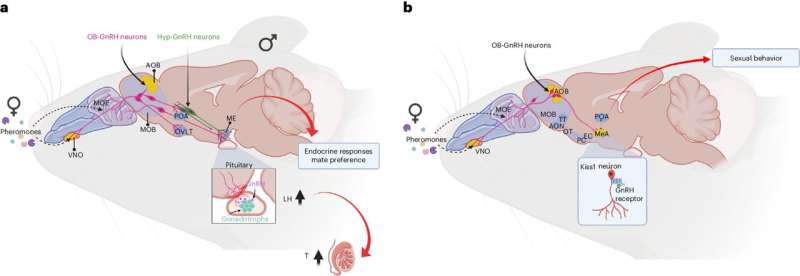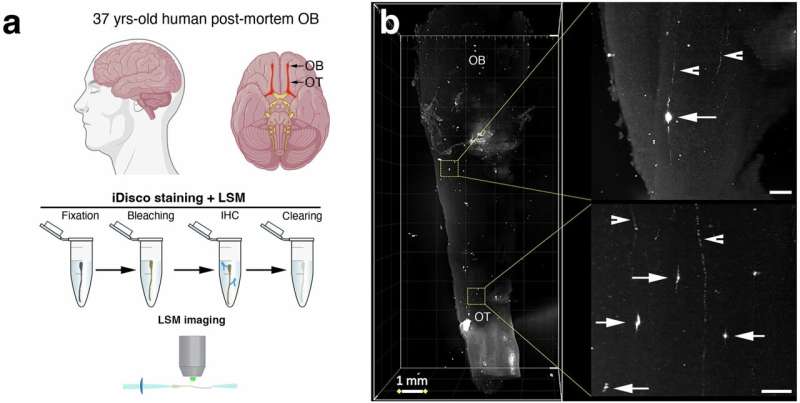August 23, 2024 feature
This article has been reviewed according to Science X's editorial process and policies. Editors have highlighted the following attributes while ensuring the content's credibility:
fact-checked
peer-reviewed publication
trusted source
proofread
GnRH neurons in the mouse olfactory bulb shown to translate socially relevant odors into male reproductive behavior

Animal reproduction is supported by the integration of various external and internal processes. These processes include a combination of perceived sensory cues, behaviors and hormone secretion.
In numerous animal species, reproduction is known to rely on the detection of sex-specific hormones, known as pheromones. These hormones are picked up by a part of the olfactory system known as the vomeronasal system.
One of the types of neurons known to play a key role in the reproduction of mammals are the so-called gonadotropin-releasing hormone (GnRH) neurons. These neurons, which are primarily located in the hypothalamus, regulate the reproductive system by controlling the release of gonadotropins from the pituitary gland (i.e., a pea-sized brain region responsible for the secretion of hormones).
Gonadotropins are crucial hormones that are responsible for the development of male and female reproductive organs, including ovaries and testes. These hormones are known to be central regulators of reproductive health, as they support processes such as ovulation, sperm production and sexual development.
Researchers at the School of Medicine in Lille (France) Labex DistAlz and other institutes in Europe recently carried out a study on mice aimed at better understanding how GnRH neurons contribute to reproduction. Their findings, published in Nature Neuroscience, suggest that GnRH neurons in the olfactory bulb of adult male mice translate socially relevant odors into reproductive behaviors.
"We show that GnRH neurons in the olfactory bulb (GnRHOB) of adult mice can mediate social recognition," Laurine Decoster, Sara Trova and their colleagues wrote in their paper.
"Specifically, we show that GnRHOB neurons extend neurites into the vomeronasal organ and olfactory epithelium and project to the median eminence. GnRHOB neurons in males express vomeronasal and olfactory receptors, are activated by female odors and mediate gonadotropin release in response to female urine."

The research team carried out a series of experiments on adult mice. Using various genetic techniques, the researchers closely observed the anatomy and connectivity of GnRH neurons in the mice's olfactory bulb, a structure in the frontal part of the brain responsible for processing smells and olfactory information.
The data collected by the researchers suggest that this population of GnRH neurons outside of the hypothalamus is responsible for integrating chemosensory cues with information about attraction sexual behavior and corresponding hormonal changes in male mice. In males, these neurons essentially pick up olfactory and hormonal cues, translating them into sexual arousal and reproductive behavior.
"Male preference for female odors required the presence and activation of GnRHOB neurons, was impaired after genetic inhibition or ablation of these cells and relied on GnRH signaling in the posterodorsal medial amygdala," the researchers wrote.
"GnRH receptor expression in amygdala kisspeptin neurons appear to be required for GnRHOB neurons' actions on male mounting behavior."
Overall, the findings gathered by Decoster, Trova and her colleagues suggest that GnRH neurons in the mouse olfactory bulb play a crucial role in the regulation of male fertility, the recognition of female mice and mating.
In the future, this recent work could inspire further research focusing on this neuronal population, including studies aimed at determining whether they play a similar role in humans.
More information: Laurine Decoster et al, A GnRH neuronal population in the olfactory bulb translates socially relevant odors into reproductive behavior in male mice, Nature Neuroscience (2024). DOI: 10.1038/s41593-024-01724-1
© 2024 Science X Network



















